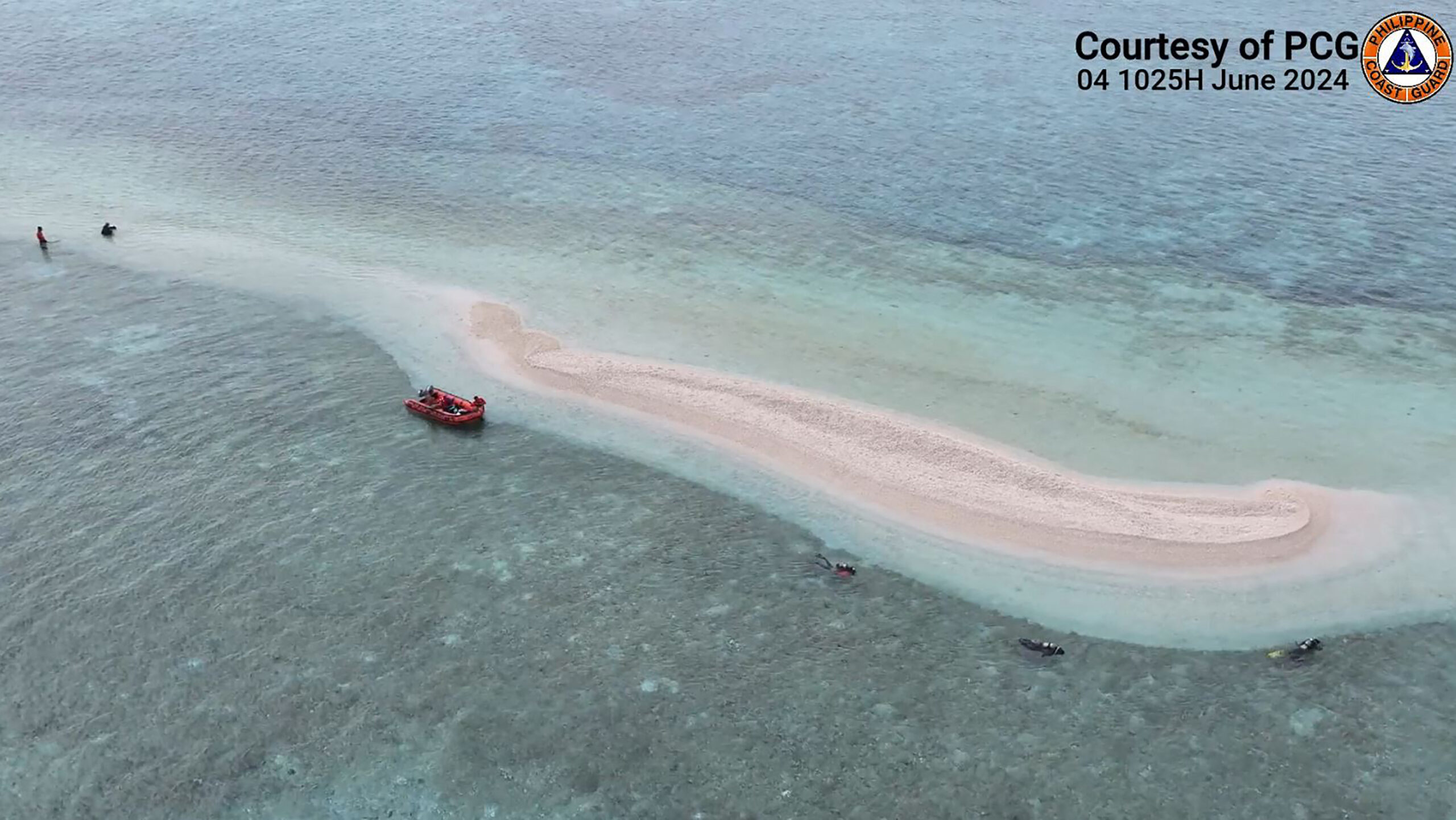
This handout photo grabbed from a video released by the Philippine Coast Guard on June 7, 2024 shows Philippine Coast Guard divers and marine scientists surveying part of Sabina shoal in the waters of West Philippine Sea. FILE PHOTO/Agence France-Presse
MANILA, Philippines — After reeling from a “siege” of Chinese ships, Philippine Coast Guard’s (PCG) BRP Teresa Magbanua left Escoda (Sabina) Shoal in the West Philippine Sea after being anchored there for more than five months.
Questions have since emerged if the PCG should send another ship there to replace Teresa Magbanua, and experts appear to be divided on the matter.
For SeaLight director Ray Powell, such a move is already “untenable” while security expert Chester Cabalza hopes the country would anchor another ship again.
READ: ‘Lugaw’ and rainwater for weeks: BRP Teresa Magbanua crew’s struggles in WPS
Powell, program head of Stanford University’s Gordian Knot Center for National Security Innovation, said Beijing has a huge flotilla of ships and warships that could overwhelm Manila’s anchored vessel.
Article continues after this advertisement
“The problem with anchoring a ship there is it’s too easy for China to isolate it, as Manila discovered with the BRP Teresa Magbanua,” Powell told INQUIRER.net on Wednesday.
Article continues after this advertisement
BRP Teresa Magbanua arrived in Puerto Princesa port on Sept. 15, arriving with four dehydrated crew who subsisted on rice porridge and rainwater weeks prior as China Coast Guard (CCG) thwarted the arrival of supplies.
Powell noted that China has a huge maritime force in its base at Mischief Reef—which is next to Sabina Shoal—giving it “the capability to project power deep into the West Philippine Sea.”
“So if it wants to essentially lay siege to an anchored ship it can do so,” he further said.
Anchored in the shoal since April 16, BRP Teresa Magbanua was the longest-deployed PCG asset in the West Philippine Sea.
However, CCG only started to disrupt the resupply missions for the flagship vessel only in August, according to Commodore Jay Tarriela, PCG spokesperson for the West Philippine Sea.
This move comes as Chinese state publication Global Times once claimed that BRP Teresa Magbanua is “semi-grounded” in Escoda Shoal, similar to what it said the country did with the BRP Sierra Madre, a grounded navy warship at the shoal’s adjacent Ayungin (Second Thomas) Shoal.
“Once China decided to treat an anchoring as if it was a ‘grounding’ and to treat Escoda Shoal as ‘territory’, anchoring became untenable over the long term,” Powell said.
“The Philippines seems to have already moved on from that,” he added, noting that the country may intend to have frequent air and sea patrols instead. “I’ve detected no interest from the Philippine side in anchoring another ship there.”
READ: PCG says Escoda pull out not a repeat of Scarborough incident
Cabalza, however, said the government should not adopt what he called a “defeatist stance” which may lead to a repeat of the 2012 incident in Panatag (Scarborough) Shoal.
“I still have high hopes that we could still ground a vessel in the Escoda otherwise we will accept a defeatist stance of the same fate we encountered in Scarborough Shoal in spite its huge geographic difference,” Cabalza, president and founder of Manila-based think tank International Development and Security Cooperation, told INQUIRER.net on Wednesday.
In 2012, Manila and Beijing had a tense standoff over Panatag Shoal, with the former withdrawing its ships from the shoal that led to the latter having an effective control of its lagoon to date. A year later, Manila lodged an arbitration case against Beijing after this standoff which led to a historic 2016 arbitral award that effectively rejected the latter’s sweeping claims in the West Philippine Sea.
Tarriela, however, previously said it would be “almost impossible” for Beijing to prevent the patrol of Manila in Sabina due to its geographical features and size.
Cabalza also said “there are many ways to counter the siege to be initiated by China.”
“If by chance they move to that military advancement, we could invite friends for the willful escort, invoke the Mutual Defense Treaty (MDT), or we may file a new international case against China,” he said.
US Indo-Pacific Command chief Adm. Samuel Paparo Jr. said Washington’s joining of Manila’s resupply mission is a “reasonable option” under the MDT, which calls for each other’s defense in case of an “armed attack.”
Armed Forces of the Philippines chief General Romeo Brawner Jr. thanked the US for such an offer, but he said the country will continue to do such missions unilaterally since it is still “very much capable” to do so.
For comprehensive coverage, in-depth analysis, visit our special page for West Philippine Sea updates. Stay informed with articles, videos, and expert opinions.

![[Time Trowel] Retire those flawed theories on how people first arrived in the Philippines](https://i2.wp.com/tvchannel.su/wp-content/uploads/2024/11/time-trowel-how-people-first-arrived-in-ph-theories-11162024-270x150.jpg)

![[Game Diary] The ‘God of War’-themed level in ‘Astro Bot’ is a joyful delight](https://i0.wp.com/tvchannel.su/wp-content/uploads/2024/09/Bot-of-War-270x150.jpg)































